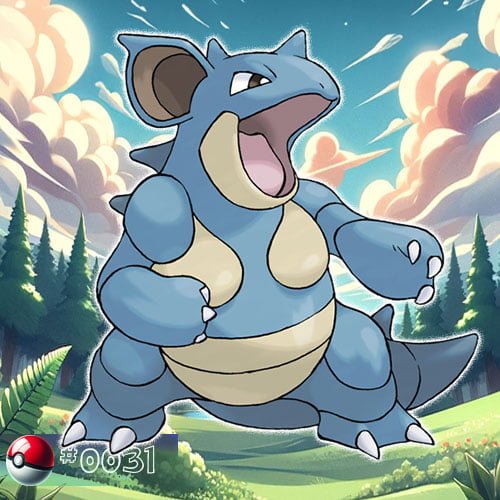Nidorina
Nidorina is a Poison-type Pokémon and the evolved form of Nidoran♀. It is known for its gentle nature and protective instincts.

| National Pokedex No: 0030 |
| Type: |
| Category: Poison Pin Pokémon |
| Height: 0.8 m (2′07″) |
| Weight : 20.0 kg (44.1 lbs) |
| Gender: 0% ♂, 100 % ♀ |
| Abilities/Hidden abilities: Poison Point or Rivalry/Hustle |
Biology
Physical Characteristics
Nidorina is a quadrupedal, light blue Pokémon with distinct physical characteristics. Nidorina’s predominant color is light blue, complemented by cream-colored areas on its belly.
Nidorina is a medium-sized Pokémon with a sturdy and well-proportioned build. Its body is compact and muscular, providing strength and agility with a pronounced chest. It possesses two prominent horns on its forehead, which are smaller than those of its evolved form, Nidoqueen.
Large, rabbit-like ears that enhance its sense of hearing. Nidorina has large, expressive eyes, giving it an alert and cautious appearance.
Its tail is long and has a unique, notched shape. The tail serves a defensive purpose, as it can release toxins. Nidorina’s paws are equipped with sharp claws, suitable for both offense and defense. The claws also highlight Nidorina’s adaptability as both a ground and poison type Pokémon.
These physical features contribute to Nidorina’s overall adaptability and effectiveness in various environments.
Behaviour
Nidorina, as a Pokémon species, displays various behaviors.
Nidorina is known for its strong maternal instincts, often becoming fiercely protective of its young. In the wild, it creates nests in hidden locations to shield its offspring from potential threats. Nidorina is territorial and may become defensive if its nest or territory is threatened. It uses its sharp claws and toxic capabilities to deter intruders and safeguard its space.
Nidorina communicates with other Pokémon and members of its species through various vocalizations. It may use body language, such as ear movements and tail positioning, to convey different emotions. Nidorina is social within its own species, often forming small groups or communities.
Nidorina is omnivorous, feeding on both plants and small prey. It uses its keen sense of smell and hearing to locate food sources, employing its claws and poison abilities for hunting. Its adaptability allows it to thrive in various habitats, from forests to grasslands.
Trained Nidorina can engage in battles, using a combination of physical attacks and Poison-type moves. Its agility and strength make it a formidable opponent in both defensive and offensive strategies. Nidorina exhibits curiosity, exploring its surroundings to discover new territories and potential resources. It may engage in playful behaviors, especially when interacting with trainers or other Pokémon.
Understanding Nidorina’s behavior provides trainers and researchers valuable insights into its ecological role and enhances the overall knowledge of this Pokémon species in the Pokémon world.
Evolution
Nidorina is the evolved form of Nidoran♀ and is part of a two-stage evolutionary line in the Pokémon series. Here’s a detailed overview of the evolution of Nidorina.
Nidoran♀ is the unevolved, basic form of the evolutionary line. It is a Poison-type Pokémon characterized by its small size, rabbit-like appearance, and pinkish coloration.
Nidoran♀ evolves into Nidorina when it reaches a certain level of experience and gains enough strength (level 16). The evolution process signifies a growth in both physical size and overall capabilities. The most common trigger for evolution is gaining experience points through battles and various in-game activities.Evolutionary stones, friendship, or other specific conditions may also induce evolution in certain Pokémon.
Upon evolving into Nidorina, the Pokémon undergoes noticeable physical changes. Nidorina becomes larger, gaining a more mature and robust appearance compared to the juvenile form of Nidoran♀. Nidorina retains some traits from Nidoran♀, such as its Poison typing, prominent ears, and pronounced claws. The coloration may intensify or change slightly, with Nidorina often featuring a more vivid and mature color palette.
Nidorina can further evolve into Nidoqueen when exposed to a Moon Stone. This evolutionary stage represents the final form of the Nidoran♀ evolutionary line. Nidoqueen is a dual-type Poison/Ground Pokémon, showcasing enhanced strength and defensive capabilities. It possesses a more complex and powerful appearance, with additional physical features compared to Nidorina.
Understanding the evolution of Nidorina is essential for trainers, as it allows them to strategize and optimize their Pokémon’s growth and battle potential within the Pokémon world.
Appearances
Anime Main Appearances
In “Wherefore Art Thou, Pokémon?”, Emily’s Nidorina, affectionately named Maria, evolved from Nidoran♀ after confronting Team Rocket and sharing a heartfelt moment with Ralph’s Nidoran♂, known as Tony.
During a Gym battle in “A Goldenrod Opportunity”, Whitney deployed her Nidorina against Ash. Unfortunately, Nidorina succumbed to Cyndaquil’s potent Flamethrower attacks.
In “The Heartbreak of Brock” Temacu’s Nidorina was seen quenching its thirst at a fountain, later taking a leisurely stroll alongside Temacu’s Nidorino. Gorman owned a Nidorina, featured in “Mad About Blue!”.
Anime Minor Appearances
In various Pokémon episodes and movies, Nidorina made appearances at Laramie Ranch, participated in races, visited Pokémon Theme Park, sensed disturbances, joined contests, and had multiple instances in different regions, showcasing its diverse and widespread presence.
In ”The Flame Pokémon-athon!”, numerous Nidorina were present at Laramie Ranch, with one participating in the Big Pokémon Race.
Other appearances include: ”Pikachu’s Vacation”, ”The Power of One”, ”A Tent Situation”, ”Tricks of the Trade”, ”Celebi: The Voice of the Forest”, ”The Legend of Thunder! ”, ”Destiny Deoxys”, ”Hi Ho Silver Wind! ”, ”Spontaneous Combusken!”, ”Not on MY Watch Ya Don’t! ”, ”Arceus and the Jewel of Life”, ”Zoroark: Master of Illusions”, ”Genesect and the Legend Awakened flashback”, ”Adventures in Running Errands! ”, ”I Choose You! ”.
”The Power of Us” featured six Nidorina, five of them were owned by different Trainers. A Nidorina appered also in ”This Could be the Start of Something Big!”.
Manga Appearances
Ash & Pikachu
Whitney, the Gym Leader of Goldenrod City’s Gym, just like her anime counterpart, possesses a Nidorina. Her Nidorina made an appearance in ”The Beginning Of Good Luck?! Pokémon Fortune Telling”.
Pokémon Adventures
Green owns a Nidoran♀ which evolved into Nidorina between the Red, Green & Blue arc and ”Valiant Venomoth!”. Later, it further evolved into Nidoqueen in the FireRed & LeafGreen arc.
In ”Off Course with Corsol”a, a Nidorina was observed inside a Poké Ball at Professor Elm’s Laboratory.
During ”The Last Battle XIII”, a Nidorina was among the Pokémon enlisted for the showdown in Ilex Forest.
Pokémon Gold & Silver: The Golden Boys
In the twenty-third and final chapter of the Pokémon Gold & Silver: The Golden Boys manga, ”Let’s Fight for the Future!!” (GB23) a Trainer’s Nidorina appeared.
Game data
Stats
Location
| Game version | Location |
|---|---|
| Pokémon Red | Route 11, Celadon City, Safari Zone |
| Pokémon Blue | Route 11, Safari Zone |
| Pokémon Yellow | Route 9, 23, Safari Zone |
| Pokémon Gold and Pokémon Silver | Routes 13, 14, and 15 |
| Pokémon Crystal | Routes 13, 14, and 15 |
| Pokémon Ruby and Pokémon Sapphire | Trade |
| Pokémon FireRed | Route 11, Safari Zone |
| Pokémon LeafGreen | Safari Zone |
| Pokémon Emerald | Trade |
| Pokémon Colosseum | Trade |
| Pokémon XD | Trade |
| Pokémon Diamond and Pokémon Pearl | Route 221, Valor Lakefront |
| Pokémon Platinum | Route 221, Valor Lakefront |
| Pokémon HeartGold and Pokémon SoulSilver | Route 13, 14, 15, Safari Zone |
| Pokémon Black | Trade |
| Pokémon White | Evolve Nidoran♀ |
| Pokémon Black 2 and Pokémon White 2 | Evolve Nidoran♀ |
| Pokémon X and Pokémon Y | Route 11 |
| Pokémon Omega Ruby and Pokémon Alpha Sapphire | Trade |
| Pokémon Sun and Pokémon Moon | Trade (Pokémon Bank) |
| Pokémon Ultra Sun and Pokémon Ultra Moon | Trade |
| Pokémon: Let's Go, Pikachu! And Pokémon: Let's Go, Eevee! | Routes 9, 10 and 23 |
| Pokémon Sword and Pokémon Shield | Trade |
| Pokémon Brilliant Diamond and Pokémon Shining Pearl | Route 221, Valor Lakefront, Grassland Cave, Swampy Cave, Dazzling Cave, Riverbank Cave, Still-Water Cavern, Sunlit Cavern, Stargleam Cavern, Bogsunk Cavern |
| Legends Arceus | Unobtainable |
| Pokémon Scarlet and Pokémon Violet | Unobtainable |
Nidorina's origin name
Nidorina’s origin name in various languages is consistent with its Pokémon species name. Here are the details.
English: Nidorina – The name is a combination of “needle” and the suffix “-rina,” suggesting a feminine or delicate quality. This reflects the Pokémon’s needle-like features and its female gender.
Japanese: ニドリーナ (Nidoriina) – The Japanese name follows a similar pattern, combining “nido” (needle) and the suffix “-riina.”
French: Nidorina – The French name stays close to the English version, using “Nidorina” to maintain consistency across languages.
German: Nidorina – Similar to English and French, the German name for Nidorina remains unchanged as “Nidorina.”
Spanish: Nidorina – In Spanish, the name is also “Nidorina,” aligning with the English and other European language versions.
Italian: Nidorina – The Italian version of the name is “Nidorina,” keeping the name consistent with the English and other European languages.
Korean: 니드리나 (Nideurina) – The Korean name is a transliteration of the Japanese name, maintaining the “Nideurina” pronunciation.
Chinese (Simplified): 尼多妮娜 (Níduōnīnà) – The Chinese name combines characters to represent “needle” and a feminine sound, reflecting the Pokémon’s characteristics.
Chinese (Traditional): 尼多妮娜 (Níduōnīnà) – The Traditional Chinese name is the same as the Simplified version, using characters that convey “needle” and a feminine quality.
These names across different languages maintain the thematic elements related to needles and femininity, consistent with Nidorina’s species characteristics and gender-specific evolution.




